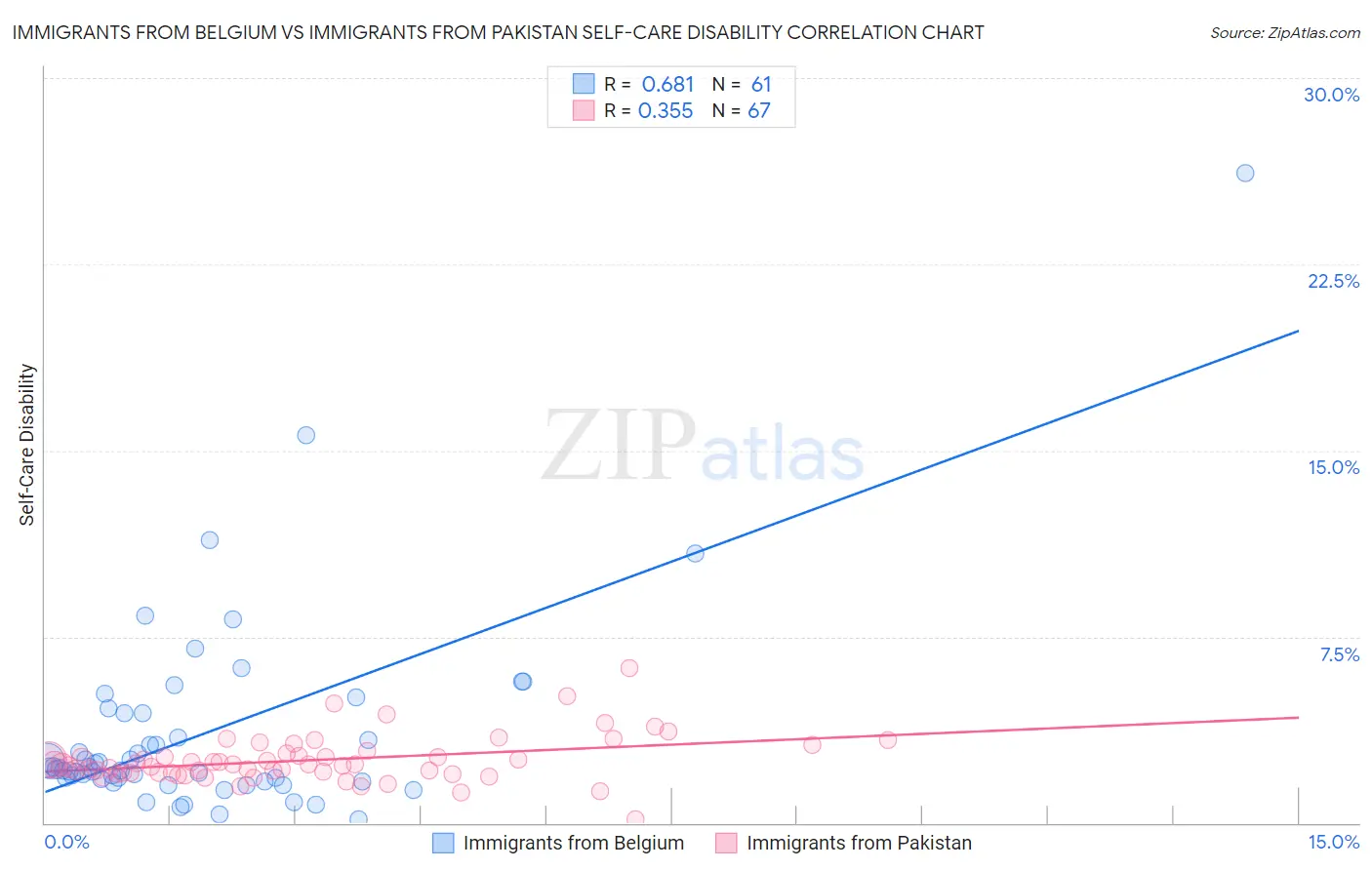Immigrants from Belgium vs Immigrants from Pakistan Self-Care Disability
COMPARE
Immigrants from Belgium
Immigrants from Pakistan
Self-Care Disability
Self-Care Disability Comparison
Immigrants from Belgium
Immigrants from Pakistan
2.3%
SELF-CARE DISABILITY
99.6/ 100
METRIC RATING
57th/ 347
METRIC RANK
2.3%
SELF-CARE DISABILITY
99.8/ 100
METRIC RATING
43rd/ 347
METRIC RANK
Immigrants from Belgium vs Immigrants from Pakistan Self-Care Disability Correlation Chart
The statistical analysis conducted on geographies consisting of 146,636,859 people shows a significant positive correlation between the proportion of Immigrants from Belgium and percentage of population with self-care disability in the United States with a correlation coefficient (R) of 0.681 and weighted average of 2.3%. Similarly, the statistical analysis conducted on geographies consisting of 283,675,484 people shows a mild positive correlation between the proportion of Immigrants from Pakistan and percentage of population with self-care disability in the United States with a correlation coefficient (R) of 0.355 and weighted average of 2.3%, a difference of 1.0%.

Self-Care Disability Correlation Summary
| Measurement | Immigrants from Belgium | Immigrants from Pakistan |
| Minimum | 0.13% | 0.14% |
| Maximum | 26.2% | 6.2% |
| Range | 26.1% | 6.1% |
| Mean | 3.6% | 2.5% |
| Median | 2.2% | 2.3% |
| Interquartile 25% (IQ1) | 1.7% | 2.0% |
| Interquartile 75% (IQ3) | 4.4% | 2.8% |
| Interquartile Range (IQR) | 2.7% | 0.78% |
| Standard Deviation (Sample) | 4.1% | 0.95% |
| Standard Deviation (Population) | 4.1% | 0.94% |
Demographics Similar to Immigrants from Belgium and Immigrants from Pakistan by Self-Care Disability
In terms of self-care disability, the demographic groups most similar to Immigrants from Belgium are Immigrants from Eastern Asia (2.3%, a difference of 0.010%), Immigrants from France (2.3%, a difference of 0.040%), Immigrants from Cameroon (2.3%, a difference of 0.070%), Argentinean (2.3%, a difference of 0.11%), and Australian (2.3%, a difference of 0.15%). Similarly, the demographic groups most similar to Immigrants from Pakistan are Immigrants from South Africa (2.3%, a difference of 0.040%), Immigrants from Uganda (2.3%, a difference of 0.050%), Norwegian (2.3%, a difference of 0.090%), Immigrants from Sudan (2.3%, a difference of 0.14%), and Czech (2.3%, a difference of 0.17%).
| Demographics | Rating | Rank | Self-Care Disability |
| Iranians | 99.8 /100 | #40 | Exceptional 2.3% |
| Immigrants | Sudan | 99.8 /100 | #41 | Exceptional 2.3% |
| Immigrants | Uganda | 99.8 /100 | #42 | Exceptional 2.3% |
| Immigrants | Pakistan | 99.8 /100 | #43 | Exceptional 2.3% |
| Immigrants | South Africa | 99.8 /100 | #44 | Exceptional 2.3% |
| Norwegians | 99.8 /100 | #45 | Exceptional 2.3% |
| Czechs | 99.8 /100 | #46 | Exceptional 2.3% |
| Jordanians | 99.7 /100 | #47 | Exceptional 2.3% |
| Immigrants | Malaysia | 99.7 /100 | #48 | Exceptional 2.3% |
| Latvians | 99.7 /100 | #49 | Exceptional 2.3% |
| Immigrants | Brazil | 99.7 /100 | #50 | Exceptional 2.3% |
| Kenyans | 99.7 /100 | #51 | Exceptional 2.3% |
| Immigrants | Serbia | 99.6 /100 | #52 | Exceptional 2.3% |
| Australians | 99.6 /100 | #53 | Exceptional 2.3% |
| Argentineans | 99.6 /100 | #54 | Exceptional 2.3% |
| Immigrants | France | 99.6 /100 | #55 | Exceptional 2.3% |
| Immigrants | Eastern Asia | 99.6 /100 | #56 | Exceptional 2.3% |
| Immigrants | Belgium | 99.6 /100 | #57 | Exceptional 2.3% |
| Immigrants | Cameroon | 99.6 /100 | #58 | Exceptional 2.3% |
| New Zealanders | 99.5 /100 | #59 | Exceptional 2.3% |
| Immigrants | Japan | 99.5 /100 | #60 | Exceptional 2.3% |